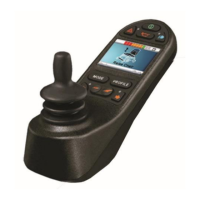If set to 24V, then the brightness of the lamps and indicators will vary with fluctuations in the battery voltage.
NOTE:
TÜV Germany requires the 12V constant brightness condition.
14.2 INDICATOR FAULT DETECTION
This sets whether defective turn indicator lamps can be detected. The detection circuitry is looking for the presence of 2 x 21W
lamps per side.
The programmable options are Yes and No.
If set to Yes, then if 2 x 21W lamps (per side) in working order are not connected to the Seating/lighting Module, a turn
indicator fault will be detected and indicated to the user (via a rapid flash of the relevant turn indicator on the Joystick Module).
If set to No, then the indicator fault detection circuitry will be turned off. This option should be used if 2 x 21W lamps (per side)
are not being used for the turn indicators.
NOTE:
TÜV Germany requires that 2 x 21W lamps per side are used for the turn indicators.
14.3 SWAP INDICATORS SEAT REVERSAL
This sets whether the left and right turn indicator channels are exchanged when the seat is reversed. The seat is considered to
be reversed when the Inhibit 2 input on the Power Module i s at 0V. For more details on seat reversal, please refer to section,
Seat Reversal.
The programmable options are Yes and No.
If set to Yes, then if the seat is reversed, the turn indicator left and right channels on the Seating/Lighting Module will be
exchanged. This option should be used if the turn indicators are mounted on the wheelchair frame.
If set to No, then if the seat is reversed, the turn indicator left and right channels will be unaffected. This option should be used
if the turn indicators are mounted on the wheelchair seat.
14.4 BRAKE LIGHTS OR HORN
This sets whether the brake light output on the Seating/Lighting Module is to be used for Brake lights or a Horn function.
The programmable options are Brake Light and Horn.
If set to Brake Light then the brake light function will be enabled.
If set to Horn, then the Horn function will be enabled.
LED INDICATOR FAULT DETECTION EXPLAINED
LED’s operate on current and their power usage is not constant or linear across the battery voltage range. The failure current
will often vary non-linearly with battery voltage depending on the type of cluster.
To accurately detect led indicator failures for a particular led cluster the failure threshold across the complete voltage ra nge
should be defined. This is done by setting five fault current thresholds

